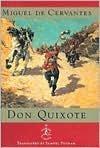Idioma Spanish
Publicado el 18 de diciembre de 1994

Idioma Spanish
Publicado el 18 de diciembre de 1994
Don Quixote is a Spanish epic novel by Miguel de Cervantes. Originally published in two parts, in 1605 and 1615, its full title is The Ingenious Gentleman Don Quixote of La Mancha or, in Spanish, El ingenioso hidalgo don Quixote de la Mancha (changing in Part 2 to El ingenioso caballero don Quixote de la Mancha). A founding work of Western literature, it is often labelled as the first modern novel and one of the greatest works ever written. Don Quixote is also one of the most-translated books in the world.The plot revolves around the adventures of a member of the lowest nobility, an hidalgo from La Mancha named Alonso Quijano, who reads so many chivalric romances that he either loses or pretends to have lost his mind in order to become a knight-errant (caballero andante) to revive chivalry and serve his nation, under the name Don Quixote de la …
Don Quixote is a Spanish epic novel by Miguel de Cervantes. Originally published in two parts, in 1605 and 1615, its full title is The Ingenious Gentleman Don Quixote of La Mancha or, in Spanish, El ingenioso hidalgo don Quixote de la Mancha (changing in Part 2 to El ingenioso caballero don Quixote de la Mancha). A founding work of Western literature, it is often labelled as the first modern novel and one of the greatest works ever written. Don Quixote is also one of the most-translated books in the world.The plot revolves around the adventures of a member of the lowest nobility, an hidalgo from La Mancha named Alonso Quijano, who reads so many chivalric romances that he either loses or pretends to have lost his mind in order to become a knight-errant (caballero andante) to revive chivalry and serve his nation, under the name Don Quixote de la Mancha. He recruits a simple farmer, Sancho Panza, as his squire, who often employs a unique, earthy wit in dealing with Don Quixote's rhetorical monologues on knighthood, already considered old-fashioned at the time, and representing the most droll realism in contrast to his master's idealism. In the first part of the book, Don Quixote does not see the world for what it is and prefers to imagine that he is living out a knightly story that's meant for the annals of all time. The book had a major influence on the literary community, as evidenced by direct references in Alexandre Dumas' The Three Musketeers (1844), Mark Twain's Adventures of Huckleberry Finn (1884), and Edmond Rostand's Cyrano de Bergerac (1897), as well as the word quixotic. When first published, Don Quixote was usually interpreted as a comic novel. After the successful French Revolution, it was better known for its presumed central ethic that in some ways individuals can be intelligent while their society is quite fanciful and was seen as a fascinating, enchanting or disenchanting book in this dynamic (and for among books). In the 19th century, it was seen as social commentary, but no one could easily tell "whose side Cervantes was on". Many critics came to view the work as a tragedy in which Don Quixote's idealism and nobility are viewed by the post-chivalric world as insane, and are defeated and rendered useless by common reality; by the 20th century, the novel had come to occupy a canonical space as one of the foundations of letters in literature.